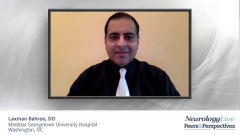
Recognizing Triggers for OFF Episodes in Parkinson Disease
Key opinion leaders in movement disorders provide insight on factors leading to OFF episodes and how to recognize and mitigate environmental triggers.
Episodes in this series

Laxman Bahroo, DO: Dr Iyer, how soon after starting therapy do you see OFF episodes?
Sanjay Iyer, MD: It varies. Often for the first 2, 3 years sometimes we have the honeymoon period, as we call it, and life is pretty good no matter what you give the patients in terms of dopamine agonist or levodopa. But the data show us that by 3 years or so, about 30% of people start manifesting some OFFs, whether they recognize it or not, and that only increases over time. Again, the challenge is helping people to understand what the OFF looks like and what it is.
Laxman Bahroo, DO: I completely agree, that honeymoon period is something that folks will look at and say, “Is this how it’s always going to be?” And I say, “No, Parkinson disease is progressive. And as we need to adjust your medications, it’s important that you keep an eye on it, because over the course of time we may adjust your medications.” Do you find that there’s a certain time of the day when their OFFs are more common?
Sanjay Iyer, MD: I do, and talking about the early morning portion, again, that’s a very common time. But after meals, depending on when patients take their medication. As we know, sometimes the protein load can impair the absorption of levodopa, and then patients don’t feel the ON, it doesn’t kick in. A great example, one of my patients on carbidopa/levodopa, 1 tablet tid, 3 times a day, was doing well 6 days a week. But on Wednesdays, he crashes in the afternoon, and what in the world is happening on Wednesday? He said, “Well doctor, my golf club has the best egg salad sandwiches, so after we finish up, we have a great sandwich for lunch.” I said, “Well, when do you take your dose?” He said, “With my egg salad sandwich.” And I said, “Well, what do you eat on most days?” He said, “Well, a salad.” There we go. So it’s just understanding the timing of when it happens. But also the late afternoon, just the fatigue and exertion, I start seeing a little more OFF time in the afternoon, suggesting they may need a short nap or a little pick me up.
Laxman Bahroo, DO: I completely agree with you because I tend to see more of these late afternoon or midafternoon OFFs. And I like you, I’m left scratching my head, I’m like, is this because of fatigue or is this because, well they had lunch and they took their dose maybe an hour later, maybe they had a heavier lunch? Or do they take food and medication close together, and was the medication not absorbed? I’m left with these 2 or 4 o’clock OFFs, and many times I look at the situation and say, is it genuinely OFF, or is this fatigue? I’ll tell them, “Why don’t we figure this out piecemeal? Why don’t you schedule a rest time, and if that resolves the issue, we’re great. If that does not, then I think we have an OFF, and either we need to modify the lunch or the medication times so we can work something out.” One of them must adjust, to see if we can do that. But I tend to see more middle day OFFs, like you mentioned, then I see early mornings, and then different time periods.
Transcript Edited for Clarity
Newsletter
Keep your finger on the pulse of neurology—subscribe to NeurologyLive for expert interviews, new data, and breakthrough treatment updates.























